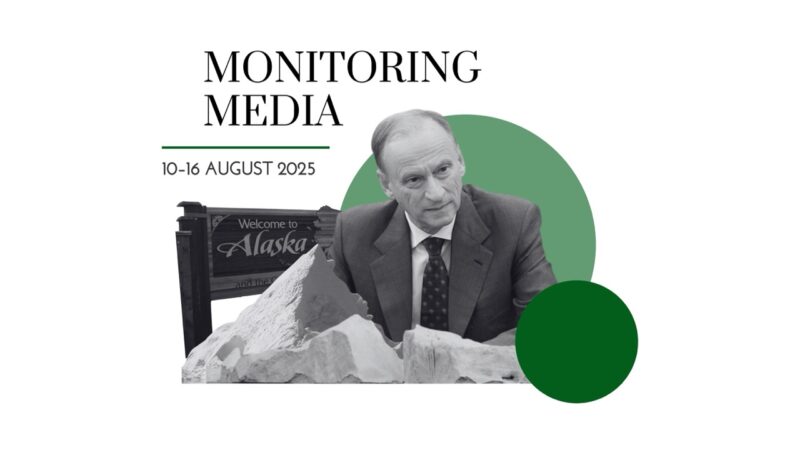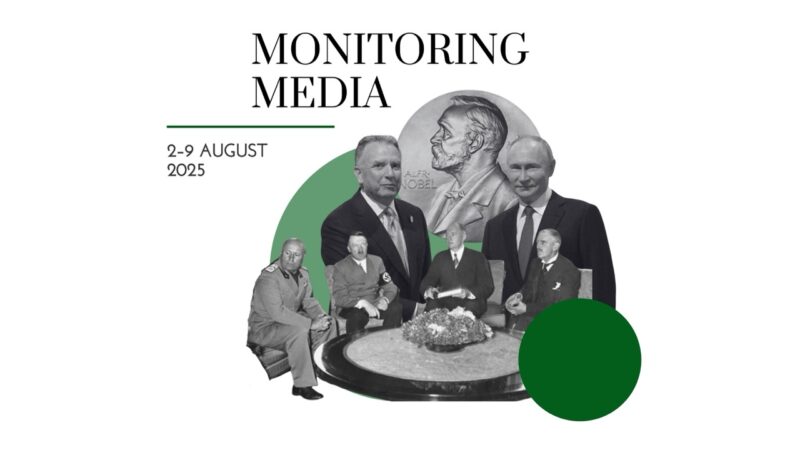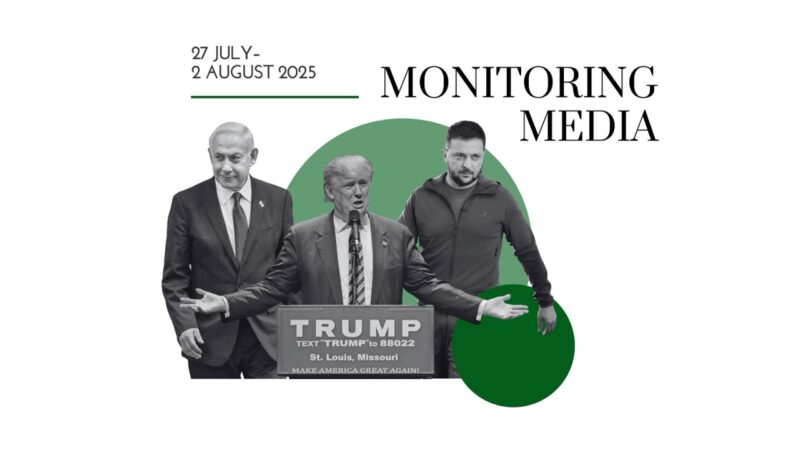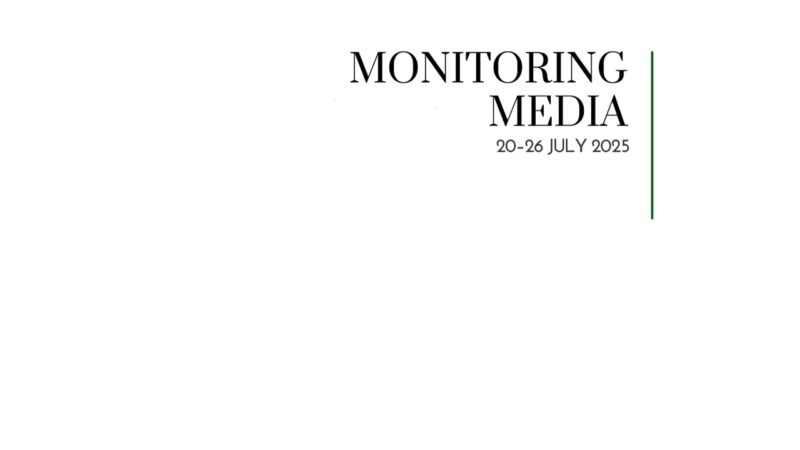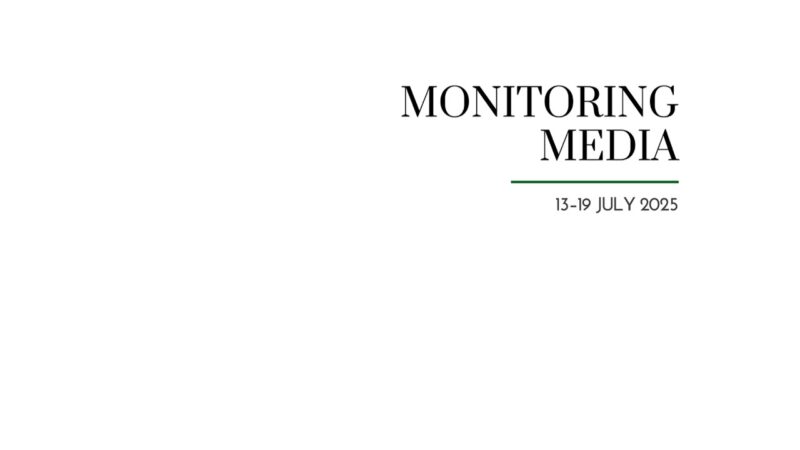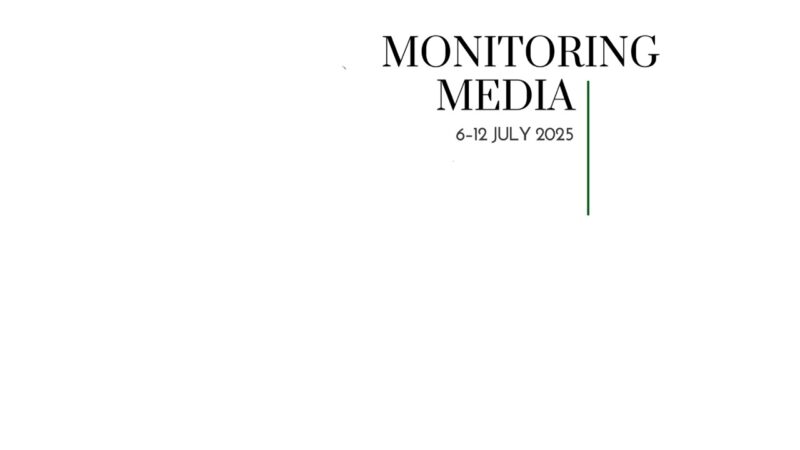Peace talks between Ukraine and Russia will pause the war, not end it

CIUS weekly report on North American media coverage of Ukrainian affairs, 25 February–3 March 2023
Three publications (The Wall Street Journal, The New York Times, and Politico) were selected to prepare this report on how the situation in Ukraine has been portrayed in the North American press during the past week (25 February–3 March 2023). The sample was compiled based on their impact on public opinion as well as on their professional reputation, popularity among the readership, and topical relevance. These three publications represent centrist and conservative viewpoints on the political spectrum.
This report covers only the most-read and relevant articles about Ukraine, as ranked by the respective North American publications themselves in the past week. Its scope covers promoted articles on home pages and articles from special sections on Ukraine, with the hashtag #Ukraine, from the paper editions of the publications, and about Ukraine from opinion columns and editorials.
Topics featured in the selected articles:
- Ukraine’s current affairs: Ukraine needs to prepare for a new wave of Russian cyber-attacks; Ukraine holds its own in Bakhmut for six months and counting;
- The world and Ukraine: The West should not only continue supporting Ukraine but help in designing a long-term strategy to end the war; the US public is becoming less interested in supporting Ukraine; the war has become a matter of global security; peace talks at the current stage of the war would lead only to a temporary armistice; south Asian energy markets have been seriously hit by the war;
- Russia at war: Putin has achieved none of his major goals in Ukraine to date.
Main arguments:
Ukraine has successfully defended its cyberspace so far, but new dangers arise. John Sakellariadis and Maggie Miller (Politico) warn that Ukraine must prepare for a new wave of Russian cyber-attacks. They cite Google’s Threat Analysis Group, which “said last week it had ‘high confidence’ that Moscow ‘will increase disruptive and destructive attacks’ in 2023 if the war shifts ‘fundamentally’ in Ukraine’s favor.” Moreover, the “cyber threat intelligence firm Recorded Future predicted this month that Russian cybercriminals will ‘almost certainly’ support Russia’s next big military push against Ukraine.” The first massive wave of attacks, launched in February 2022 and still continuing, has been neither effective nor coordinated. Ukrainian defence forces were ready to counter them and quickly managed to restore the damaged infrastructure. However, since the beginning of the invasion, Russian state-funded hackers have significantly improved their skills and seem to have discovered new weaknesses in Ukraine’s cyber defences. They also are believed to have learned how to coordinate their cyber-attacks with kinetic warfare (i.e., support invading Russian infantry). Furthermore, a recent threat has emerged: Russia may attack the IT infrastructure of NATO states—specifically, those supporting Ukraine. Sakellariadis and Miller conclude that Ukraine and its allies will likely defend themselves ably against the coming Russian cyber-attacks, but today’s refinement of the new tools of warfare will significantly change the character of future conflicts.
The town of Bakhmut remains in the epicentre of fighting in the Donbas. Matthew Mpoke Bigg and Edward Wong (New York Times) write that in light of unceasing Russian attacks, the Ukrainian command decided to send reinforcements to Bakhmut. However, very little is known about the strength and mission of these reinforcements. The authors put forward three hypotheses: the new troops can be used to dig in and increase the defensive force exerted on Russians; they may be used to preoccupy the Russians so they cannot move to different battlefields; or they could improve logistical support for Ukraine’s long-rumoured withdrawal from Bakhmut. Mpoke Bigg and Wong assume that preparation for withdrawal is the major reason for sending reinforcements, as the town has been levelled and is therefore very hard to defend.
Marcus Walker (Wall Street Journal) adds to this that Russia has been trying to seize Bakhmut since last summer. Recently, the invaders have achieved some success as they managed to advance to the north and south of Bakhmut, surrounding the town on three sides. Conquering the town is apparently of great symbolic importance to the Kremlin, which desperately needs a victory to report to Russian citizens. In strategic terms, however, the town poses little value, as it is located on low ground, far from major transportation hubs.
The longer the fighting lasts, the worse situation Ukraine finds itself in. William A. Galston (Wall Street Journal) argues that the US and its allies should speed up the delivery of military equipment to Ukraine, because every day of delay works in Russia’s favour: Putin “is putting his economy on a wartime footing, which will increase the production of artillery and ammunition… After a faltering start, he has managed to nearly double the number of Russian troops in Ukraine… He said the West’s effort to cripple Russia’s economy has failed, the ruble has stabilized, growth is resuming… Russia will continue the war until it achieves its objectives, however long that might take.” Instead, the Ukrainian side wants the war to end as soon as possible because they want to save its soldiers’ lives and prevent further damage to civilian (and military) infrastructure. For these reasons, the West should become more proactive and deliver—in addition to the already confirmed main battle tanks—long-range high-precision missiles and modern jet fighters to Ukraine. Galston argues that any kind of settlement on Russia’s terms and/or “freezing” of the conflict would also work to Putin’s advantage. Therefore, “if Ukraine can cut the land bridge to Crimea and destroy the bridge Russia has built over the Kerch Strait, Mr. Putin might be forced to stand down.”
The US should assist in designing a multi-pronged long-term strategy to end the war. Jonathan Lemire and Eli Stokols (Politico) write that while President Biden’s visit to Ukraine on 20 February was “an act of defiance meant to mark the one-year anniversary of the war,” the transatlantic alliance is feeling more and more strain as “the war has no end in sight.” The new waves of the Russian offensive have already brought it some territorial gains, and China is considering increasing its support to the Kremlin. Moreover, US elections in 2024 and German elections in 2025 are on the horizon, which may influence their promises to support Ukraine “as long as it takes.” In this light, Lemire and Stoklos cite US analysts who believe that 2023 will be the best chance Ukraine has to liberate its occupied territories. The analysts also believe that the White House through its diplomatic efforts and German regional leadership remain the most significant powers keeping the unity of Europe together. That being said, two public opinion camps have appeared in Europe on how to deal with the war: the first suggests that Russia should not be crushed on the battlefield and peace talks with Putin have always been the only reasonable option; the second camp advocates utter military defeat of the aggressor and dismantling of Putin’s regime so that the Russian threat will completely disappear from the continent. Lemire and Stokols conclude that the US should draft a comprehensive long-term strategy in order to preserve European unity, secure the strong unified stance of Ukraine and the West, prevent the conflict from becoming “frozen,” discourage China from supporting the aggressor, and mitigate Russia’s nuclear escalation. These and other strategic topics were discussed during Chancellor Scholz’s visit to the White House on 3 March.
US public resolve to support Ukraine in fighting against Russia is softening. Peter Baker (New York Times) highlights that “proponents of more aid fear that growing taxpayer fatigue toward shipping tens of billions of dollars overseas could undercut the war effort.” The most recent surveys by the Associated Press-NORC Center for Public Affairs Research demonstrate that public support for Ukraine aid has fallen from 60 per cent in May 2022 to 48 per cent in February 2023. Ukraine supporters argue that such a drop is natural—every overseas military crisis loses the sympathy of US citizens after some time; things look even worse in the case of Ukraine because US citizens do not connect a war in Central Europe to their own security. To that, Baker adds that two major Republican presidential candidates are increasingly speaking against US involvement in Ukraine’s affairs. At the same time Baker highlights that according to President Biden, “the cost of walking away could be considerably higher than the cost of helping Ukraine maintain its independence.” Bipartisan support for Ukraine remains powerful in Congress, too. Baker cites US security analysts who argue that “uncertainty is all the more reason for the president to be aggressive and help the Ukrainians win the war sooner, before public support fades further.” Russia should not be allowed to snatch victory from the jaws of defeat, as this would bring the worst possible outcome for the US.
The West now perceives the war in Ukraine as a matter of global security. Yaroslav Trofimov (Wall Street Journal) writes that attitudes toward the Russo-Ukrainian war in the West have evolved from passive acceptance of the inevitable fall of Kyiv in early 2022 to consent for shipments of heavy weapons in early 2023. Having acknowledged Ukraine’s successful resistance and its ability to fight back, today the West sees the war as one of its own and supports Ukraine to an unprecedented level: “If this monumental effort fails to thwart President Vladimir Putin’s ambitions, the setback would not only undermine American credibility on the world stage but also raise difficult questions about the future of the Western alliance.” The discovery of extreme Russian cruelty in territories it occupied in Ukraine and the Kremlin’s fatal improficiency on the battlefield were the major factors that encouraged the West to adopt a more active stance. Apart from that, “it’s not just the fate of Europe that is being decided [in] Ukraine … in Asia, the Middle East and elsewhere, the West’s geopolitical adversaries are calculating whether the US and its allies have the stamina and cohesion to defend the rules-based international order that has benefited the West for decades.” If Putin and his henchmen achieve their objectives in Ukraine, this may encourage other authoritarian leaders around the world to expect no consequences as they embark on violence against neighbouring states and individuals. Instead, the stronger Western support for Ukraine becomes today, the faster it will liberate all of its occupied territories, and international law will be stronger for it as well. Trofimov also writes that with Ukraine’s military industries shattered and depleted, it is only Western support that allows it to continue defending. That being said, war fatigue is slowly spreading among the allies. In this light, President Zelensky is doing brilliant work; as a professional actor and communicator, he speaks skillfully to different audiences across the globe and emphasizes their moral duty to help Ukraine win. Zelensky’s rhetoric has recently become more powerful than Putin’s nuclear blackmail and attempts to sow fear. Trofimov ends by quoting President Biden that “Ukraine will never be a victory for Russia” and that the “appetites of the autocrat cannot be appeased; they must be opposed.”
A genuine peace between Ukraine and Russia cannot be established through negotiations today. Michael Kimmage and Hanna Notte (Wall Street Journal) open their article with the statement that “peace talks with Russia are pointless unless Putin gives up his ambition to push the US and NATO from Eastern Europe.” In light of China’s recently proposed peace initiatives, Türkiye’s efforts to mediate talks between the fighting sides, the EU’s desire to resolve tensions in its backyard, and US fears that the conflict may become a “forever war,” a new wave of pressure is being put on Ukraine to negotiate a settlement with Russia. However, as Kimmage and Notte highlight, any kind of negotiations today will not lead to a genuine resolution of the war. For that to take place, three conditions must be met. First, Russia must accept Ukraine “as a diplomatic interlocutor [i.e., a country with agency] rather than a poker chip on the European playing field.” Secondly, Russia and Ukraine must affirm “an agreement on the territorial configuration of Ukraine, including Crimea and other parts of Ukraine illegally occupied by Russia.” Thirdly, some binding consensus between Russia and the West must be established “about Russia’s place in Europe, especially in relation to the independent states on its borders.” None of these conditions is being seriously considered by the Kremlin. Instead, it continues pursuing its pre-invasion objectives, which are to make Ukraine “either deferential to Russia or destroyed” and diminish US influence in Central and Eastern Europe. Kimmage and Notte conclude that “patience not to engage in premature diplomacy is essential for Ukraine and for the West.”
Michael Crowley (New York Times) adds that Russia has recently started signalling its openness to negotiations. However, at the same time it has increased its military pressure on Ukraine and “insists that Ukrainians accept Russian annexation of large swaths of their territory as a condition of peace.” Crowley suggests that the Kremlin’s peace-loving rhetoric is a guise that aims “to placate allies, cast the opposition as unreasonable and, especially on the Ukrainian side, tamp down a growing desire within Western countries to find an end to the costly war.” Such rhetoric is also intended to make a powerful impact on India, South Africa, and Brazil, which have not yet decisively taken sides in the war.
Developing countries are suffering energy shortages because of the Russian invasion. Benjamin Storrow and Sara Schonhardt (Politico) write that rather than Europe, as was anticipated, disruptions in gas and oil supply are affecting Asian countries the most. In light of the worldwide invasion-induced deficits, energy-exporting countries decided to reroute their cargo ships to richer European markets. This disclosed a major distortion in the global energy system: “Those that can afford to pay rising prices are buying up energy resources such as natural gas, while preparing for climate change by developing renewable power such as wind and solar. Those that can’t are slipping back into the grip of dirtier fuels—or going dark.” To mitigate their shortages, developing Southeast Asian states have resorted to burning coal, a move that risks jeopardizing global efforts to prevent climate change. Storrow and Schonhardt highlight that before the Russian invasion, natural gas export was a very regionalized business, administered through a network of pipelines—particularly between Russia and Europe. Meanwhile, LNG was mainly delivered by sea from the US to Asian markets (India, Pakistan, Philippines, Indonesia, and Bangladesh). However, “when Putin ordered the attack on Ukraine, Europe retaliated by turning to the US and a few other countries to replace the gas it once received from Russia. US shipments to Europe more than doubled in 2022, to 2.7 trillion cubic feet.” That has not only led to increased energy shortages in Southeast Asia but drastically increased fossil fuel prices in the region, and the turn back to coal happened as a matter of course. Storrow and Schonhardt cite a Pakistani economist who believes that “climate change is a long-term issue. In the near term we need to keep the lights on.”
After a year of heavy fighting, Putin has achieved none of his goals in Ukraine. In her op-ed Angela Stent (Politico) writes that “in many ways, Russia’s president has already lost his war on Ukraine.” In particular, Putin has yielded his claim for global leadership, Russia’s reputation as a great power has shrunk, Russia’s diplomatic and economic ties with the West have been severed, Ukraine has developed one of the best armies in Europe and is on the path to the EU and NATO, and Ukrainians have forged a unified national identity and developed hatred towards Russians. Stent argues that one year into the invasion, Putin has achieved completely opposite results to those he anticipated. Nevertheless, China remains rather supportive of the Kremlin’s venture and is using Russia as a useful lever in the current stage of great power competition. Furthermore, the Kremlin continues to enjoy support among many Global South countries, especially those run by authoritarian leaders whose regimes rely on the Wagner mercenary group. At home, Putin has forced Russia’s political elites into accepting the war as something inevitable and rallied the citizenry around the government by employing propaganda and repressions. Stent concludes that “Russia may still have the largest number of nuclear warheads and a veto on the UN Security Council, but it will have lost its seat at the table of global leadership.”
